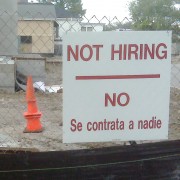How Do I Find Blue Collar Employees?
Blue collar jobs have long suffered from an image crisis, despite blue collar employees enjoying a high level of job satisfaction.
According to a study by The Harris Poll, 85 percent of blue-collar workers enjoy job satisfaction and are optimistic about the direction of their life. Yet, most high school graduates are opting to pursue a four-year degree. As a result, enrollment in Career and Technical Programs, where many students go to learn skilled trades, is at an all-time low.
Throw in an infrastructure bill and an all-around labor shortage, most businesses will be struggling to find blue-collar employees for the foreseeable future. Finding blue collar employees takes a mix of understanding this demographic, addressing its image and training issues, and being a whiz at advertising blue-collar jobs on the most relevant jobs sites.
Blue Collar Meaning
Finding blue-collar workers begins with understanding the term. Blue-collar generally refers to any job requiring manual labor. For decades, these workers didn’t require much technical know-how. Most learned their trade on-the-job, hiring into factories or construction companies right after high school.
Today, though, blue collar jobs refer to a wide-range of skill levels and pay scales. Electricians can make up to $98,000, while machine operators make less than $30,000. Many skilled blue-collar jobs require very little formal education. Instead, paid internships offer a path to licensing and employment.
Bias Surrounding Different Types of Collar Jobs
The blue-collar worker’s image is tied to our perception of social class in America. Even the term “blue-collar” is a reference to the dirt and grime associated with these workers who wear durable blue clothes that resist stains. In contrast, “white-collar” workers are associated with clean offices and intellectual work.
Blue-collar bias even affects college grads who come from a working-class background. In one study, researchers sent fake resumes to top offices and law firms in Australia. The resumes were identical as far as education and work experience. Some resumes, however, included upper-class hobbies, such as polo and sailing. Other resumes included typical working-class activities, such as track or country music. The resumes from presumably upper-class candidates received far more callbacks than those with working-class extracurricular activities.
But like many of our biases, these stereotypes have no place in our modern workplace. Blue-collar workers are indispensable. Anyone who’s had a broken pipe in their house or a fallen tree on their roof can attest: plumbers, construction workers, electricians and others build and maintain the framework for our society.
And they’re starting to get more respect. Blue-collar employees are seeing a 10 percent wage growth, compared to only 7.5 percent for their white-collar counterparts. And, according to this article about blue-collar stigma in Deseret News, “20 percent of technical certificate holders make more than the average [bachelor’s degree].”
Despite the surge in demand for blue-collar employees, many don’t enjoy the same perks white-collar employees take for granted. They often get less paid time off. When they go to work, they often don’t get free coffee from the breakroom or clean restrooms, often making do with a thermos from home and porta-potties.
Increasing Blue Collar Jobs Training
Fighting against the stigma attached to blue-collar employees is the first step to encouraging enrollment in trade schools and apprenticeship programs.
If your company isn’t already participating in your local high school’s career day, it’s time to get started. Representatives from your company can educate students about a blue-collar employee’s wage potential. You can also educate students on the costs of trade school as compared to a four-year university and the rising demand for blue-collar workers.
You should also be in contact with your local high school’s counselors throughout the year. Make sure they’re aware of the opportunities for blue-collar employees at your company. Talk to your local school board about setting up a vocational education program for kids still in high school. Encourage blue-collar jobs training by offering scholarships to trade schools. Or perhaps your company can offer paid, on-the-job training.
Use your social media outlets to promote blue collar jobs. There’s a large, grassroots movement to promote trade schools and end the bias against working-class workers. Relentless promoter of blue-collar trade schools and host of the TV show Dirty Jobs, celebrity Mike Rowe is never far from the spotlight and a great source for shareable articles. Create a Google alerts for search terms such as “trade schools” or “blue-collar” so you’ll never run out of content to share on your social media pages.
Finding Blue-Collar Employees
Promoting trade schools to current high school students is an effective long-term strategy for finding blue-collar employees. But it isn’t how to recruit blue-collar workers for the openings you have today. You can find blue-collar employees for your immediate openings by expanding your talent pool and advertising on the sites where blue-collar workers are.
You can actively recruit blue-collar workers by targeting specific groups. Many veterans already possess the training they need to excel in your blue-collar job openings. Check veterans’ job fairs in your local community or online. A Regional Veterans’ Employment Coordinator can help you connect with veterans seeking blue-collar employment in your community.
You can find blue-collar employees through a largely untapped talent pool. Former offenders usually get overlooked by hiring managers. But a third of U.S. adults have a criminal record. Including these individuals in your search for blue-collar employees is the right thing to do and more important than ever in the current labor shortage. Some local and state governments are offering incentives for hiring justice involved candidates in addition to the tax credit provided by the federal government.
You can find blue-collar employees on sites like Indeed if you use these effective keywords.
- Skilled Trades
- Apprentice
- Manufacturing
- Operator
- CDL
But you’ll be able to find even more blue-collar employees if you expand your job advertising to other, niche sites. Bluecollarcrossing.com is job board that help employers find blue-collar workers in all industries. Also look for niche job boards for your industry. careersinwelding.com, tradesmen-electrician.jobs, and cdljobs.com are several examples. “Jobs on Facebook” is a new paid advertising site on the social media giant and an effective place to find blue-collar workers.
Hiring for Blue-Collar Jobs
The current labor shortage probably has you wondering more than ever, “how do I find blue-collar employees”. By addressing the stigma around blue-collar workers and promoting trade schools in your area, you can position yourself to find blue-collar employees in the near future. But by directing your recruiting efforts to marginalized groups and your job advertisement campaigns to blue-collar workers and the sites they frequent, you can hire for your immediate openings.
ExactHire ATS can help you improve your time-to-hire metrics for all of your open positions. You’ll be able to access over 25,000 job boards and advertise your job openings with one click. You can then monitor each job site’s performance to learn which sites perform best for your company.
ExactHire ATS also makes it easy for blue-collar workers to apply to your open positions with a mobile-friendly careers site and application. You can even seamlessly text with your applicants from within the software. You can run a report rather than sift through files when it comes time to file for your Work Opportunity Tax Credit.
To learn more about how ExactHire can help you find blue-collar employees, contact us today.
Photo by Jason Richard on Unsplash










 15% OFF FULL-SERVICE HIRING • APPLICANT TRACKING SOFTWARE • ONBOARDING SOFTWARE
15% OFF FULL-SERVICE HIRING • APPLICANT TRACKING SOFTWARE • ONBOARDING SOFTWARE